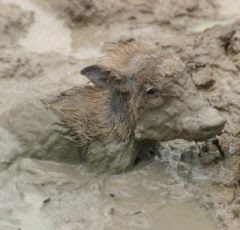Yesterday's post was about the roles human psychology and ecomonics played in the recent disaster at the Burns Lake sawmill. Today's will attempt to show how rapid climate change and the accompanying rapid spread of the mountain pine beetle's habitat also played a big part in the disaster.
The mountain pine beetle has been around for millions of years. It's habitat has grown and shrunk many times through all those years in response to the climate it needs to survive. Like everything, the mountain pine beetle has an important role to play in the dance of nature. Its role is forest renewal. Without vectors like the pine beetle the forests couldn't evolve in parallel with the environment and would suffer.
Through those millions of years the waxing and waning of the climate's parameters has taken hundreds or thousands of years to move the borders of different species, including the beetle's, any appreciable distance. Moving along with the beetles are its predators, its hosts and other factors like the age of the forest and the consequent spacing and ages of the trees. Now though we are faced not with the slow natural climate variations of the past but a new set of circumstances caused by the rapid changes taking place that are easily measured in decades. In response to these rapid climate changes of today certain species, like those with legs, wings-or in the case of the beetles-trapeze like filaments can move more quickly than the forests who must rely on the much slower process of reseeding to move.
Our distant cousins, the beetles, who's range is limited to areas where 30-40 consecutive days of -40C don't occur, have in just a few decades marched north because the winters in parts of the northern hemisphere where these these parmeters used to always occur aren't quite as cold for quite as many consecutive days as they have been in the past. Not only climate change has helped their northern migration, in addition they've found that we humans have altered the natrual forest's age ranges by our logging practices. See, another factor in the ability of the beetles to spread rapidly is the spacing between trees. In a mature forest the distance between large trees- determined by sunlight avalibility, fire and species-is much larger than in a forest occupied by trees of approximately the same age as happens after logging regardless of whether natural reseeding of replanting has occured. Our cousins travel from tree to tree by dangling trapeze like on a filament swinging in the wind, the closer the trees are together the easier and more quickly they can move.
So, we've created the perfect marching conditions and our cousins have marched. In response to the widespread death of the lodgepole pine and a growing number of other types of pines have produced losses of expected revenue that the harvest of these second growth pine forests should have, in the capitialist's opinion, brought in. We now are harvesting these standing dead and dried trees as fast as possible to extract as much money as possible from them before they fall over, as they naturally would, and decompose into the food the next type of trees who should be moving in to replace the pines will need to eat to sustain themselves.
Whew. Which brings us back to the Burns Lake Mill and why the extra dry dust content in the air that fateful day was so high that, along with the shuttering of the ventalation windows because of the -48C tempratures and the natural gas leak in the basement, caused the huge explosion that killed 2 innocent men and injured 19 others. The natural gas leak in and of itself couldn't have been the only factor because natural gas concentratrions must reach a certain level before they become explosive. In a huge volume of air like the sawmill building long before those concentrations were reached all the workers would have had headaches or nausea or felt like they were about to passed out, they didn't. So perhaps in a smaller zone, like the basement or a thermally stratified small corner, the natural gas did reach explosive concentrations that were then ignited by a spark from the machinery or a welding torch but the resulting explosion couldn't have blown the roof off such a huge building, there had to be another source of energy and that was the huge quantity of extra dry dust created in the building by the processing of the dry dead remains of the infested pine forests.
Who caused the explosion and fire? We all did our part. By rapidly consuming, as we all do, the carbon sequestered over geologic time frames to power our lifestyles. We created the conditions that destroyed the lives and broke the hearts of the folks in Burns Lake. For my part in that i'm truely sorry.
Climate Change and Pine Beetles - To understand just how complex, scary and immediate climate change is, look no further than the case of the tiny mountain pine beetle.
Comments and Articles on some of the important issues of our times from a bottom up perspective. We're all stakeholders. We're all in this together. Ashes to ashes, mud to mud.
The Mud Also Rises

The commentaries and posts here are written and published by Bob Wiley from the hideout in Black Point. The goal of The Mud Report is to help provide leadership from the bottom.
Search This Blog
Contact Us
Blog Archive
- October (1)
- May (1)
- April (1)
- March (6)
- February (8)
- January (11)
- December (9)
- November (12)
- October (15)
- September (8)
- August (11)
- July (9)
- June (1)
- May (2)
- April (5)
- March (14)
- February (20)
- January (13)
- December (16)
- November (14)
- October (10)
- September (3)
- August (7)
- July (7)
- June (11)
- May (17)
- April (20)
- March (27)
- February (20)
- January (18)
- December (16)
- November (9)
- October (9)
- September (10)
- August (17)
- July (19)
- June (25)
- May (24)
- April (26)
- March (23)
- February (20)
- January (26)
- December (22)
- November (20)
- October (19)
- September (24)
- August (31)
- July (23)
- June (24)
- May (29)
- April (23)
- March (29)
- February (28)
- January (21)
- December (17)
- November (24)
- October (1)
- March (3)
- February (21)
- January (20)
- December (29)
- November (30)
- October (26)
- September (19)
- August (23)
- July (24)
- June (26)
- May (30)
- April (30)
- March (31)
- February (28)
- January (31)
- December (22)
Links
La Via Campesina is the international movement which brings together millions of peasants, small and medium-size farmers, landless people, women farmers, indigenous people, migrants and agricultural workers from around the world. It defends small-scale sustainable agriculture as a way to promote social justice and dignity. It strongly opposes corporate driven agriculture and transnational companies that are destroying people and nature.
Sitting Up Mud
"Bokonon made mud. Bokonon said to some of the mud, "Sit up!" "See all I've made, the hills, the sea, the sky, the stars."
And I was some of the mud that got to sit up and look around. Lucky me, lucky mud. I, mud, sat up and saw what a nice job Bokonon had done.
"Nice going, Bokonon. Nobody but you could have done it, I certainly couldn't have. I feel very unimportant compared to You. The only way I can feel the least bit important is to think of all the mud that didn't even get to sit up and look around. I got so much, and most mud got so little. Thank you for the honor!"
Now mud lies down again and goes to sleep. What memories for mud to have! "What interesting other kinds of sitting-up mud I met! I loved everything I saw! Good night. Amen."
-Kurt Vonnegut, Jr
And I was some of the mud that got to sit up and look around. Lucky me, lucky mud. I, mud, sat up and saw what a nice job Bokonon had done.
"Nice going, Bokonon. Nobody but you could have done it, I certainly couldn't have. I feel very unimportant compared to You. The only way I can feel the least bit important is to think of all the mud that didn't even get to sit up and look around. I got so much, and most mud got so little. Thank you for the honor!"
Now mud lies down again and goes to sleep. What memories for mud to have! "What interesting other kinds of sitting-up mud I met! I loved everything I saw! Good night. Amen."
-Kurt Vonnegut, Jr
Quotes
"Our dreams draw us foward, as water whispers to the dowser's wand."- Tony Cohan
"Religion is not merely the opium of the masses, it's the cyanide." - Tom Robbins
"Politics is how you live your life, not who you vote for!" -Jerry Rubin
"The pencil is mightier than the pen"- Robert Pirsig
"Resist much, obey little." -Walt Whitman
When the axe came into the woods, many of the trees said, “At least the handle is one of us.” — Turkish proverb
"Men never do evil so completely and cheerfully as when they do it from a religious conviction" - Pascal
"It is difficult to get a man to understand something when his salary depends on his not understanding it." - Upton Sinclair
"Religion is not merely the opium of the masses, it's the cyanide." - Tom Robbins
"Politics is how you live your life, not who you vote for!" -Jerry Rubin
"The pencil is mightier than the pen"- Robert Pirsig
"Resist much, obey little." -Walt Whitman
When the axe came into the woods, many of the trees said, “At least the handle is one of us.” — Turkish proverb
"Men never do evil so completely and cheerfully as when they do it from a religious conviction" - Pascal
"It is difficult to get a man to understand something when his salary depends on his not understanding it." - Upton Sinclair
Translate
The single greatest service each of us can provide to our planet, our families and ourselves is to grow our own organic food from heritage seeds. Then to save our own seed in turn, and in so doing be part of the future solution to the present day destruction being sown by GMO's, agri-business and the bio-technology giants. - Bob Wiley



